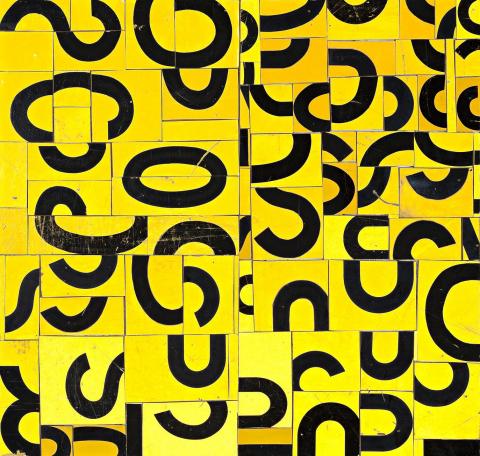BYZANTIUM, 1997
ROSALIE GASCOIGNE
retro-reflective road sign on board
78.0 x 82.0 cm
signed, dated and inscribed with title verso: Rosalie Gascoigne / 1997 / BYZANTIUM
Private collection, Canberra, acquired directly from the artist in 1997
Medusa, 1998, reflective synthetic polymer film on wood, 70.0 x 70.0 cm, private collection, illus. in Gellatly, K., Rosalie Gascoigne, Council of Trustees of the National Gallery of Victoria, Melbourne, 2008, p. 104
Rosalie Gascoigne first showed her art publicly in 1974, at the age of 57. Four years later she was the subject of a solo survey exhibition at the National Gallery of Victoria and eight years later she represented Australia at the 1982 Venice Biennale.1 With no formal art training, Gascoigne’s entry into the art world had not been anticipated, but the impact she had on it throughout a three-decade career is indisputable. Combining an innate drive to collect – not valuable or precious items, but objects that had been discarded or that she found in nature – and an unerring eye for structure, pattern, texture and tone, Gascoigne’s distinctive aesthetic represented one of the most individual contributions to contemporary Australian art of the late twentieth century.
Although she used a wide range of materials, Gascoigne’s oeuvre is strongly identified with works such as the monumental Monaro, 1989 (Art Gallery of Western Australia), composed of slats made from timber soft-drink crates (here, the familiar yellow and black of the Schweppes brand) and others including Flash Art, 1987 (National Gallery of Victoria) and Metropolis, 1999 (Art Gallery of New South Wales), made of recycled retro-reflective road signs. While the worn painted timber of the soft-drink crates had an immediate appeal, the shiny surface and vivid colour of the road signs was at first too much for Gascoigne who initially collected a pile of them, along with high-visibility vests and other material discarded by road workers, as props for her grandchildren’s games.2 Sometime later, on a day following rain, she saw the signs anew and the first retro-reflective work was made in 1985.3
Gascoigne said of these works, ‘… I’ve always liked the glint to be brought out. I don’t want it to be dramatically lit, but I do want it to sometimes flash at you, as roadsigns do, and then go sullen, then flash, like a living thing …’4 There is a palpable sense of energy in Gascoigne’s art, a product of the way in which she worked with her materials, fragmenting and dividing them into smaller irregular components that were rearranged like pieces of a puzzle, the solution to which could only be found through her singular vision. In Byzantium, 1997, this feeling is further emphasised by the changing play of light across the work’s jewel-like surface and the focus on the curves of black letters and numbers as abstracted graphic forms, that rotate, twist and turn in a constant dancing motion. Peter Vandermark, who assisted Gascoigne in the studio, recalls Byzantium being cut into several sections that were swapped and reordered until the final composition emerged and even then, after the work had been signed, the artist once again reversed its orientation for display.5 Gascoigne worked intuitively and as this example shows, her work was never finished until it left the studio. Her ‘processes remain[ed] deceptively simple’, as Deborah Edwards has noted, and ‘while [her works] speak of minimal intervention with material, they are entirely transformative in their effect. It is in the entwining of process and material that content lies’6 and in which the poetry of Gascoigne’s art is found.
1. Gascoigne shared this honour with Peter Booth.
2. Macdonald, V., Rosalie Gascoigne, Regaro, Paddington, 1998, p. 35
3. Ibid.
4. Gascoigne, R., quoted in Gellatly, K., ‘Rosalie Gascoigne: Making Poetry of the Commonplace’, Rosalie Gascoigne, exhibition catalogue, National Gallery of Victoria, Melbourne, 2008, p. 13
5. Vandermark, P., quoted in ‘Peter Vandermark and Marie Hagerty in conversation with Mary Eagle’, Eagle, M. (ed.), From the Studio of Rosalie Gascoigne, exhibition catalogue, Drill Hall Gallery, Australian National University, Canberra, 2000, p. 25
6. Edwards, D., ‘Material as Landscape’, Rosalie Gascoigne: Material as Landscape, exhibition catalogue, Art Gallery of New South Wales, Sydney, 1998, pp. 12 – 13
KIRSTY GRANT
